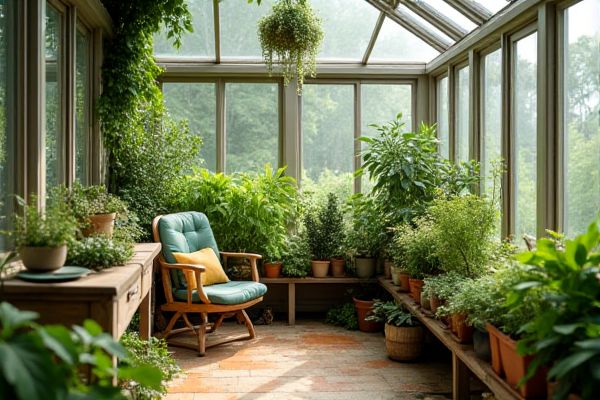
Hydroponic sunroom gardening offers faster growth and higher yields by delivering nutrients directly to plant roots through water, while soil-based methods provide natural benefits like microbial activity and easier maintenance. Explore the full comparison to decide which sunroom gardening approach suits Your needs best.
Table of Comparison
| Aspect | Hydroponic Sunroom Gardening | Soil-Based Sunroom Gardening |
|---|---|---|
| Growth Medium | Water-based nutrient solution | Natural soil or potting mix |
| Water Usage | Up to 90% less water than soil gardening | Higher water consumption due to soil absorption |
| Nutrient Control | Precise and easily adjustable | Dependent on soil quality and amendments |
| Growth Rate | Faster, up to 25-50% more rapid growth | Standard growth speed, slower than hydroponics |
| Space Efficiency | Higher density planting possible | Requires more space per plant |
| Pest & Disease Risk | Lower soil-borne disease risk | Higher risk due to soil pathogens |
| Setup Complexity | Moderate to high; requires equipment and monitoring | Low; simple setup with soil and containers |
| Cost | Higher initial investment | Lower initial costs |
| Maintenance | Requires regular nutrient and pH monitoring | Routine watering and soil care |
Introduction to Sunroom Gardening Methods
Sunroom gardening methods primarily include hydroponic and soil-based approaches, each offering unique advantages for indoor plant cultivation. Hydroponic gardening uses nutrient-rich water solutions to grow plants without soil, promoting faster growth and efficient resource use in controlled environments. Soil-based sunroom gardening relies on traditional soil mediums, enhancing natural nutrient cycles and providing a familiar growing experience for a wide variety of plants.
Hydroponic Gardening: Definition and Overview
Hydroponic gardening is a soilless cultivation method where plants grow in nutrient-rich water solutions, allowing precise control over nutrient delivery and environmental conditions. This technique enhances growth rates and yields by optimizing oxygen and nutrient availability directly to plant roots. Compared to traditional soil-based gardening, hydroponics reduces water usage and minimizes space requirements, making it ideal for sunroom setups with limited area.
Soil-Based Gardening: Traditional Approach Explained
Soil-based gardening in sunrooms relies on natural soil as the growing medium, providing essential nutrients and microbial life that support plant health. This traditional approach benefits from soil's ability to retain moisture and organic matter, enhancing root development and plant resilience. Despite requiring more space and potential pest management, soil gardens offer a familiar, sustainable method for growing herbs, vegetables, and flowers indoors.
Key Differences Between Hydroponic and Soil-Based Systems
Hydroponic systems deliver nutrients directly to plant roots through a water-based solution, enabling faster growth and higher yield compared to soil-based methods, which rely on nutrients naturally found in or added to the soil. Soil-based sunroom gardening supports beneficial microorganisms and a more traditional plant environment, but it requires more maintenance and is prone to pests and soil-borne diseases. Your choice between hydroponic and soil gardening depends on available space, maintenance preference, and desired crop productivity.
Space and Setup Requirements in Sunrooms
Hydroponic sunroom gardening requires less space as it eliminates the need for soil, enabling vertical or compact setups that maximize your sunroom's limited area. Soil-based gardening demands more room for pots and soil storage, along with consistent maintenance to prevent pests and soil-borne diseases. Optimizing your sunroom setup depends on space availability and your preference for handling plant nutrition delivery systems.
Growth Rates and Plant Health Comparison
Hydroponic sunroom gardening offers faster growth rates compared to soil-based methods due to direct nutrient delivery and optimized water usage. Plants grown hydroponically typically exhibit healthier root systems and higher yields since they avoid soil-borne pests and diseases. Your choice will impact plant vitality, with hydroponics often providing more consistent and robust growth in controlled sunroom environments.
Nutrient Management in Hydroponics vs Soil
Hydroponic sunroom gardening enables precise nutrient management by delivering a tailored solution directly to plant roots, optimizing growth and minimizing waste. In contrast, soil-based gardening relies on the natural nutrient content and microbial activity of the soil, which can vary widely and often requires regular amendments for balanced fertility. Hydroponic systems allow instant adjustments in nutrient concentration and pH levels, promoting faster plant development compared to the slower nutrient cycling in soil environments.
Maintenance and Labor Considerations
Hydroponic sunroom gardening typically requires less physical labor since it eliminates soil preparation, weeding, and frequent watering, relying instead on nutrient solution management and system upkeep. Soil-based gardening demands regular tasks like tilling, mulching, and pest control, often involving more manual effort and time investment. Efficient hydroponic systems can reduce maintenance frequency but require vigilance in monitoring water quality and pH levels to ensure optimal plant growth.
Environmental Impact of Each Method
Hydroponic sunroom gardening significantly reduces water usage by up to 90% compared to traditional soil-based methods, minimizing environmental strain. Soil-based gardening often relies on pesticides and fertilizers that can leach into local ecosystems, whereas hydroponic systems use controlled nutrient solutions, reducing chemical runoff. Choosing hydroponics for Your sunroom garden supports sustainability by decreasing resource consumption and lessening harmful environmental impacts.
Which Sunroom Gardening Method Is Right for You?
Hydroponic sunroom gardening offers faster plant growth and higher yields by delivering nutrients directly to roots, making it ideal for space-conscious gardeners seeking efficient maintenance. Soil-based sunroom gardening provides a natural environment, supporting diverse plant species and promoting beneficial microbial activity, favored by those valuing traditional cultivation methods and soil health. Choosing between hydroponics and soil depends on factors like available time, plant variety preferences, and the desire for either minimized watering or a more organic growing medium.
 homyna.com
homyna.com